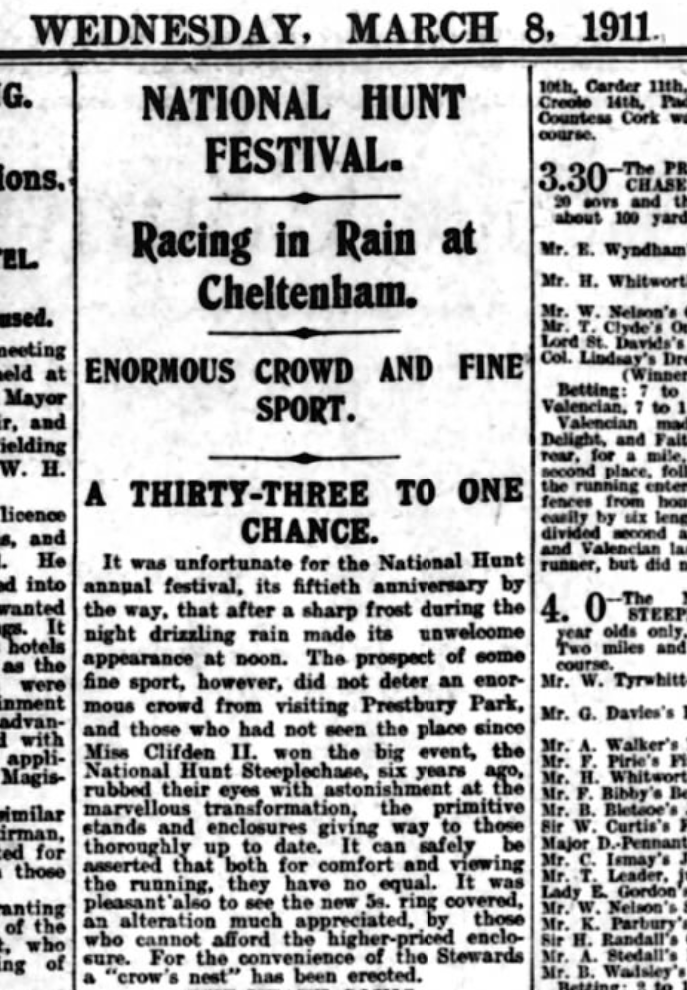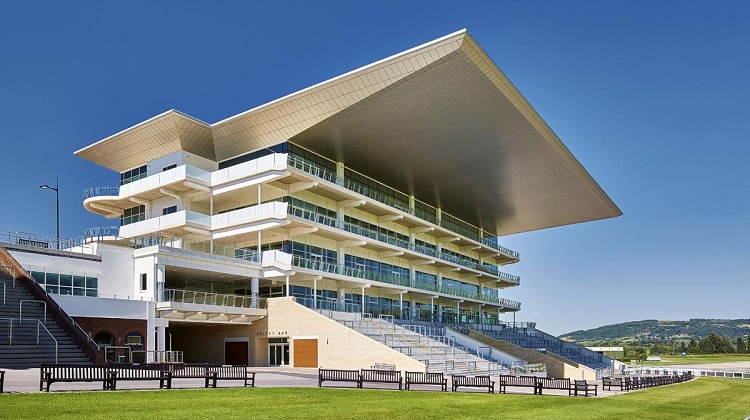The Cheltenham Festival is done and dusted for another year and while crowds were down and Constitution Hill's absence a big blow, there was still much to enjoy.
Willie Mullins' celebrated his 100th Festival winner when Jasmin De Vaux, ridden by his son Paddy, won the Champion Bumper on Day 2.
By the end of the week, the Iegendary trainer had celebrated a total of nine winners, bringing his Cheltenham Festival tally to 103.
That included Galopin des Champs, who landed back-to-back Gold Cups to maintain Ireland’s stranglehold on the Festival showpiece.
It was also a fourth Gold Cup for Paul Townend, drawing him level with Pat Taafe as the most successful jockey in the history of the race.
Inevitably, the countdown to the 2025 Festival has already begun and we have the ante post Cheltenham Odds for next year's big races.
We also detail relevant trends and statistics for all 28 Festival Races, including video replays.
Follow our Festival updates on X (Twitter) and via our exclusive WhatsApp channel.
In 2023 we tipped ten winners, including 16/1, 22/1 and 66/1 shots, while in 2024 it was eight winners, including 28/1 and 10/1 selections.
But this year we also recommended perming tri-casts covering all horses apart from the hot favourite in the Champion Chase.
There were five runners apart from El Fabiolo, with 60 bets required to cover all combinations.
The winning line returned at almost 12,000/1:
— Cheltenham Festival Fans (@cheltfestfans) March 14, 2024
If you want to place a bet on the Festival, it is worth checking out all the latest bookmaker Cheltenham betting offers and free bets.

The Cheltenham Festival is the Olympics of jumps racings and for thousands, being at Prestbury Park in March is an annual ritual.
Played out against the backdrop of Cleeve Hill, a breathtaking natural sporting arena, it is quite simply the place where legends are made.
The four day meeting stages championship races in pretty much every discipline that national hunt racing has to offer, be it over hurdles, fences or even on the flat.
There are races for novices - the stars of the future - and the blue riband events that all jockeys, trainers and owners dream of winning.
They include the Champion Hurdle, the Champion Chase and, the most prestigious race of them all, the Cheltenham Gold Cup.
When discussing the greatest horses to ever jump an obstacle, a horse that hasn’t won at the Festival won’t even get a mention.
Instead, the Festival is inextricably linked with the cream of the thoroughbred crop.
From Golden Miller, who won a record five Gold Cups, and Arkle and Best Mate who each claimed three, to triple Champion Hurdlers like Persian War, See You Then and Istabraq.
Every year reputations are made and lost at the Festival, which has served up some of the most dramatic and emotional moments of any sport.
Nobody who witnessed it will ever forget Dawn Run’s Gold Cup in 1986, when the Irish mare become the first horse to win both the Champion Hurdle and Gold Cup.
Or Desert Orchid’s success in the same race in 1989, finally laying his Cheltenham hoodoo to rest by adding the sport’s biggest prize to his already glittering CV:
More recently, Kauto Star and Sprinter Sacre regaining their crowns in 2009 and 2016 respectively will live long in the memory.
There have been exceptional human feats too, like Michael Dickinson training the first five in the 1983 Gold Cup and Ruby Walsh riding seven winners in both 2009 and 2016.

There is one other ingredient that makes the Festival so special - the crowd.
The phrase “The Roar” is synonymous with the wall of noise that erupts from the stands when the tapes go up for the traditional curtain raiser, the Supreme Novices' Hurdle.
It's a roar that tells the world the 12 month wait for the best four days in sport is finally over.
The Cheltenham Festival originated from the annual 'National Hunt Meeting' which first took place in Market Harborough in 1860, featuring the National Hunt Steeplechase.
This nomadic meeting was held at different venues across the UK, selected each year by the National Hunt Committee, including at Prestbury Park in 1904 and 1905.
A former medieval deer park, 'three fields' within Prestbury Park had first been used for flat racing from 1831 to 1834.
It also hosted steeplechases from 1848 until 1854 - when the land was sold to a new owner opposed to racing.
But in 1881 the Prestbury Park estate was bought by William Baring Bingham and racing finally returned from 1898, with an official two-day meeting in April 1902.


The 'Cheltenham Steeplechase Company' was formed in late 1907, and Frederick Cathcart made clerk of the course.
Under his guidance, various improvements were made to the track and facilities, including a new grandstand in 1908.

When it again played host to the National Hunt Meeting in 1911, the substantial changes made to the racecourse helped ensure it would remain a permanent home of the Festival.

The meeting was extended to three days in 1923, with the Gold Cup added in 1924 and the Champion Hurdle in 1927.
The entire Cheltenham Festival was abandoned in 1931 due to frozen ground, while in 1937 heavy rain and snow meant that the final day was lost, with no Gold Cup run.
From 1940 to 1942 the Festival was reduced to two days and was held on successive Saturdays in 1942, due to wartime restrictions.
There was no Festival at all from 1943 to 1945, but in 1945 a Cheltenham Gold Cup and a Champion Hurdle were run, two weeks apart, on Saturday meetings at Cheltenham.
The Festival was again abandoned due to frost in 1947 with five principal races ran instead at the 'Spring Meeting' in April.
And the same fate befell the final day in 1949, with just the Gold Cup moved to April.
The second two days of the 1951 Festival were cancelled due to flooding, with various major races again run in April.

In 1954 the first live television coverage of the Cheltenham Festival took place on the BBC, with Peter O'Sullevan commentating.
Snow meant that the second day of the 1955 Festival was abandoned just 20 minutes before the gates were due to be opened.
The 'National Hunt Two-Mile Champion Chase' was established in 1959, which was renamed the Queen Mother Champion Chase in 1980.
In November 1964 the course was purchased by the Racecourse Holdings Trust, seeing off a real threat from property developers (and talk of the Festival moving to Sandown).
That consortium was headed by Johnny Henderson, father of current trainer Nicky.
The ‘New’ Course, which runs in a wider arch than the original, was first used in 1967.
In 1975 the first day of the Festival was lost due to a waterlogged course and the final three races after the Gold Cup were also abandoned due to the atrocious conditions.
While in 1978 the third day was cancelled due to snow, with the Triumph Hurdle and Gold Cup run instead in April.
The main grandstand overlooking the winning post was completed in 1979 and the parade ring with terraced viewing, plus the weighing room, were added in 1982.
And in 1995 the idiosyncratic Cross Country Course was added to the infield.
In 2001 the Festival was cancelled due to an outbreak of the foot-and-mouth epedemic.
Another day was added in 2005, with five new races introduced, while futher races added since means that there are now a total of 28 - compared to 12 back in 1911.
In 2008 the second day of the Festival was abandoned due to high winds, with those six races rescheduled to extended cards on the Thursday and Friday.
In 2015 Cheltenham Racecourse opened the new Princess Royal Stand, the final part of a £45 million redevelopment of the course.

Although known as the 'Cheltenham Festival' for many years, its official name remained the National Hunt Festival until 2005, when 'National Hunt' was removed from the name.
Cheltenham isn’t just about equine heroes and many of the sport’s finest jockeys secured their legacies by winning big races at the Festival.

The leading Festival rider of all time is Ruby Walsh who partnered with legendary trainers Paul Nicholls and Willie Mullins to dominate the Festival from the turn of the century.
Walsh actually rode the first of his 59 winners here in 1998 as an amateur, and he went on to be leading jockey at the meeting 11 times.
His victories include two Gold Cups on Kauto Star in 2007 and 2009, and four Champion Hurdles - all for Mullins.
By contrast, his three Champion Chase successes were all for Nicholls: Azertyuiop (2004) and Master Minded (2008 & 2009).
Incredibly, two horses contributed ten of his victories as he won the Stayers Hurdle four times on Big Buck’s and the Mares Hurdle six times on Quevega.
His last win came on the Mullins trained Klassical Dream in the 2019 Supreme.

Next on the all-time list is Barry Geraghty with 43 winners at the Festival.
Few jockeys relished the meeting more than Geraghty, who seemed to be able to up his game for the big occasion.
He was leading rider at the meeting twice (2003 & 2012), with his first winner having come abroad the legendary two mile chaser, Moscow Flyer, in the 2002 Arkle.
He went on to win two of his five Champion Chases aboard Moscow Flyer.
Those five wins ties the all time record by a jockey and he also holds the record for most wins in the Arkle (4) and Triumph Hurdle (5).
His last Festival came in 2020, when he rode five winners for JP McManus, for whom he was the retained rider at the time.
Geraghty’s longevity and consistency really stand out and he rode at least one winner at every Festival between 2002 and 2016 - he missed the 2017 meeting through injury.

Arguably the greatest jump jockey of them all, Sir Anthony McCoy, is next on the list of most successful Festival jockeys with 31 winners.
Given his numerical supremacy when it comes to winners generally, it is perhaps surprising to see AP behind Messrs Walsh and Geraghty on the Festival roll of honour.
But he still had some magical days at the Festival and his 2009 win on Wichita Lineman was arguably the finest ride ever seen here:
McCoy’s first winner came on Kibreet in the 1996 Grand Annual and he went on to land all of the big three, registering a final tally of three Champion Hurdles, one Champion Chase and two Gold Cups.

Paul Townend is the leading active jockey with 27 winners, unsurprising given the unparalleled backing he has as stable jockey of the all-conquering Willie Mullins yard.
It was at the 2020 Festival where Townend really started to make his mark, riding five winners, following up with three in 2021, before another five in both 2022 and 2023.
Highlights include back to back victories in the Gold Cup with Al Boum Photo (2019 & 2020) and also in the Champion Chase on board Energumene (2023 & 2023).
He also rode Galopin Des Champs to victory in the 2023 Cheltenham Gold Cup.

Pat Taaffe’s record of 25 winners is all the more remarkable for the fact that he rode in an era long before the four day Festival.
He is the only jockey to have won four Cheltenham Gold Cups, thanks mainly to his association with the great Arkle.
Like Barry Geraghty, he rode five Champion Chase winners, including one on board another legend of the sport: Flyingbolt.

Davy Russell also rode a total of 25 winners at the Festival, starting back in 2006 on board Native Jack in the Cross Country Chase.
That victory started a remarkable run that saw him ride a winner at every Cheltenham Festival until the sequence was finally broken in 2019.
He was another of the top jockeys who really came into his own on big race days and few riders have ever ridden this unique course as well as the Irishman.
He will probably be remembered most for his association with Tiger Roll, with whom he won the Triumph Hurdle in 2014 to kick off one of the sport’s greatest fairytales.
He also won the Gold Cup on Lord Windermere in 2014 and rode four winners for Gordon Elliott in 2018, his best return at the Festival.

Most of Nico de Boinville’s 16 winners at the Festival have been for Nicky Henderson, including three on board Altior.
Other notable wins include an unforgettable comeback win for Sprinter Sacre in the Queen Mother, and a Gold Cup on the novice Coneygree in 2015.
De Boinville rode Constitution Hill to victory in the Supreme Novices' Hurdle in 2022 and then in the Champion Hurdle in 2023.

Rachael Blackmore has quickly established herself as the Queen of Cheltenham and already has a total of 14 winners at the Festival since her first in 2019.
In 2021 she rode six winners, including the Champion Hurdle with Honeysuckle, en route to becoming the first female to be crowned the leading rider at the Festival.
She was also second in the Gold Cup that year, as A Plus Tard was denied by Minella Indo, both trained by Henry de Bromhead, with the rider having had to make the tough choice between the pair.
However, it didn’t take her long to lay those demons to rest, with A Plus Tard winning the 2022 Gold Cup by a remarkable 15-lengths.
Thus, she already has two Champion Hurdle's and a Cheltenham Gold Cup on her Festival CV.

Jack Kennedy’s was 17 when he rode the first of his 11 winners at the Festival on the Gordon Elliott trained Labaik in the Supreme Novices'.
Indeed, he owes much of his Festival success to his association with Elliott and Gigginstown.
It was for that trainer/owner combination that he won the last two renewals of the Cross Country Chase, aboard Delta Work.
In 2018 he won four races at the Festival matching the tally of the week's leading rider, Davy Russell. However, Russell won the title as he had ridden more placed horses.
He also won the 2021 Cheltenham Gold Cup on Minella Indo.
But his best ride was arguably on Mount Ida in the 2021 Kim Muir Chase, who came from a detached last to first thanks to Kennedy’s cajoling, having touched 999/1 in running.
When analysing form ahead of any Cheltenham Festival race few individual factors seem to be more significant than course form.
The importance of the ability to perform at Cheltenham in general and at the Festival, in particular, are hard to overstate. It is remarkable how many horses save their best form for this track and how many seem to relish returning to the Festival each year.
There are actually two separate tracks at Cheltenham, plus a Cross Country Course set out in the middle of Prestbury Park.
The Old Course is used on Tuesday and Wednesday, with fresh ground on the New Course preserved for Thursday and Friday.
So how do the two circuits differ and what qualities does a horse need to excel on either?

The first thing to note is that the Old Course is a sharper track.
Lots of people talk about needing stamina to win at Cheltenham given the hill that runners have to climb on the run to the line.
But horses also need a certain amount of speed because on the Old Course, over shorter trips like two miles in particular, the runners are always on the turn meaning that it is very hard to hold a position if you are on a horse that isn’t travelling.
It is also hard to regain track position if you lose it, so a combination of speed and balance is very important.
This is further emphasised by the steep run downhill that confronts the field as it turns out of the back straight - if your rivals start to get away from you at this point it is very hard to reel them in and make up the lost ground.
Balance is also needed to safely negotiate the obstacles.
The second last fence, in particular, can catch horses out as it comes at a point in the race when horses are starting to tire. It also comes quickly after the final bend and has changed the course of many big races over the years.
Another trappy area is the run of three fences down the back straight that includes two open ditches, with a plain fence sandwiched in between. Miss the first ditch and you can easily fluff all three and lose the race, even though it is still a long way home from here.
The New Course is more of a staying circuit with jockeys generally having a bit more time to organise their mounts during races here.
So it is crucial to be on a strong stayer, but you need a good jumper too as there are some tricky obstacles to negotiate over both hurdles and fences.
On the hurdles course, the first flight down the back straight can catch horses out as they tend to start freewheeling after turning downhill away from the grandstands.
Equally, the second last is also taken downhill, with the ground starting to rise shortly afterwards and the change in levels can see horses lose their footing, even if they jump this flight cleanly.
Over fences, after you have turned out of the back straight the next fence is taken on the hill, which can unbalance even the most surefooted of jumpers.
Whichever course you race on, one thing that they both have in common is the uphill climb to the line.
This is where history is made, dreams are realised and shattered, and fortunes are won and lost.
One thing is for certain, however well the previous 90% of the race has gone, it will all be for nothing unless your horse has the heart to overcome this final test.
The third course at Cheltenham is the most unique.
Introduced in 1985 to coincide with the start of Sunday racing, the Cross Country Course is a combination of twists and turns on the flat, and bespoke obstacles to be jumped.
Those obstacles comprise banks, ditches and rails, as well as the most spectacular of them all - the cheese wedges.
The course was originally designed by Mike Etherington-Smith, who also designed the 3 day event course for the Sydney Olympics.
However, since its inception, the course has been modified on a number of occasions. For example, the cheese wedges were added in 2009.
In addition, changes were also made after a controversial Cross Country Chase in November 2008, where jockey Davy Russell took a legal shortcut that didn’t follow the normal racing line.
Unlike normal steeplechase fences, which are constructed from ‘dead’ materials, the fences are living, growing trees, shrubs and bushes, which have to be trimmed for racing.
The course is the only one of its kind in the UK, although similar style races are run every year at the likes of Punchestown in Ireland and Pau in France.